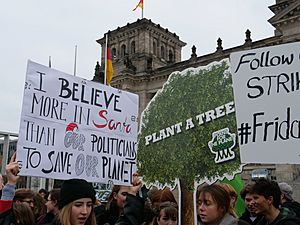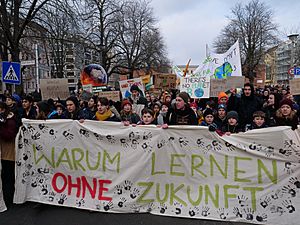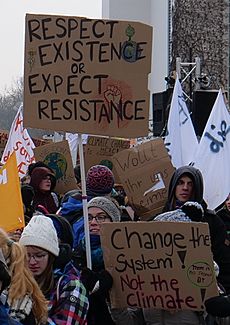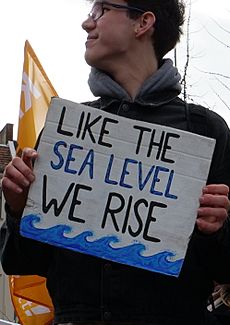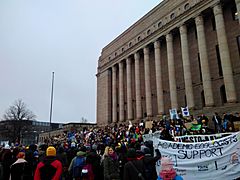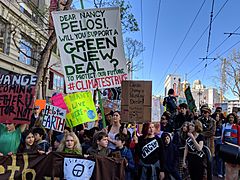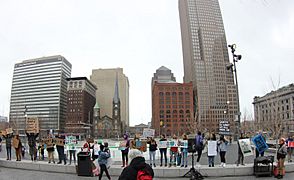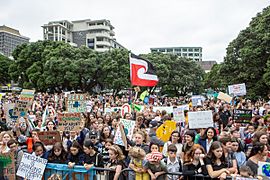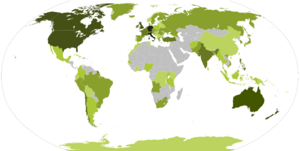School strike for the climate facts for kids
Quick facts for kids School strike for climate |
|||
|---|---|---|---|
| Fridays for Future Part of the climate movement |
|||
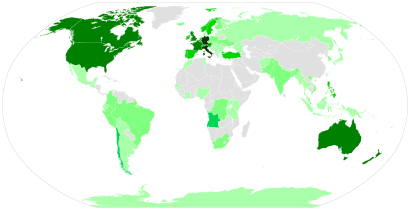
Maximum number of school strikers per country.
|
|||
| Date | Since August 2018, mostly on Fridays, sometimes on Thursdays | ||
| Location |
International
|
||
| Caused by | Political inaction against global warming | ||
| Goals | Climate change mitigation | ||
| Methods | Student strike | ||
| Status | Active | ||
| Parties to the civil conflict | |||
|
|||
| Lead figures | |||
|
|||
| Number | |||
|
|||
The school strike for the climate, also known as Fridays for Future (FFF), is a worldwide movement. School students take time off from class. They join protests to demand action against global warming and climate change.
This movement became well-known after a Swedish student, Greta Thunberg, started protesting. In August 2018, she sat outside the Swedish parliament. Her sign said "School strike for the climate."
On March 15, 2019, over one million students joined a global strike. About 2200 strikes happened in 125 countries. Another big strike on May 24, 2019, saw hundreds of thousands of protesters. These events happened around the time of the 2019 European Parliament election.
The Global Week for Future in 2019 included 4500 strikes. They took place in over 150 countries. The strikes on September 20 gathered about 4 million protesters. Many were schoolchildren. This included 1.4 million people in Germany. On September 27, over 1 million people protested in Italy.
Contents
How the Climate Strike Movement Started
In late 2015, a group of students invited others to skip school. This was on the first day of the 2015 United Nations Climate Change Conference in Paris. On November 30, a "Climate strike" happened in over 100 countries. More than 50,000 people took part.
The movement asked for three main things:
- 100% clean energy
- Keeping fossil fuels in the ground
- Helping climate refugees (people who have to leave their homes because of climate change)
Greta Thunberg's First Strike in 2018
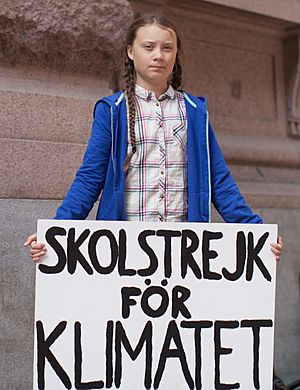

On August 20, 2018, Greta Thunberg was a ninth-grade student in Sweden. She decided not to go to school until the 2018 Sweden general election on September 9. This was after heat waves and wildfires hit Sweden.
Greta was inspired by teen activists in Florida. They had organized the March for Our Lives. Greta protested by sitting outside the Swedish parliament every school day. Her sign read "School strike for the climate." She demanded that the Swedish government reduce carbon emissions. This was to follow the Paris Agreement.
On September 7, she announced she would strike every Friday. She would continue until Sweden followed the Paris Agreement. She created the slogan "FridaysForFuture." This idea spread around the world. It inspired students everywhere to join student strikes.
Greta later sailed to New York City. She continued to raise awareness about the climate crisis. She planned to join school strikes in the U.S. and speak at the UN Climate Summit.
The Movement Grows Worldwide
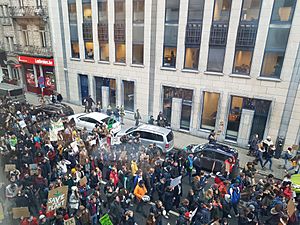
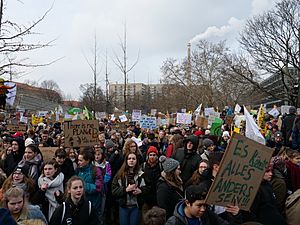
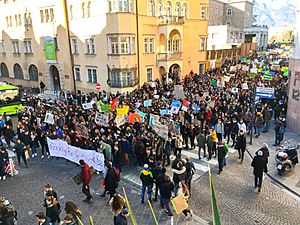
Inspired by Greta, strikes began around the world in November 2018. In Australia, thousands of students started striking on Fridays. They ignored their Prime Minister Scott Morrison's advice. He had asked for "more learning in schools and less activism."
After the COP24 Climate Change Conference in Poland, strikes continued. By December, they were in at least 270 cities. These included Australia, Austria, Belgium, Canada, Germany, and the UK.
In 2019, strikes grew to include Colombia, New Zealand, and Uganda. On January 17 and 18, over 45,000 students protested in Switzerland and Germany. They were against weak policies on global warming. In some countries, students asked for the voting age to be lowered to 16. This would let them vote for leaders who support climate action.
In Germany, local groups organized using WhatsApp. They spread their messages with flyers and social media. By February 2019, the movement had over 155 local groups.
On February 5, 2019, a Belgian environment minister resigned. She had falsely claimed that the school strikes were a "set-up."
In the UK, on February 13, 2019, 224 academics supported the students. They signed an open letter for the School Strike for Climate. On February 15, over 60 protests happened in the UK. About 15,000 students took part.
On February 21, 2019, the President of the European Commission, Jean-Claude Juncker, spoke next to Greta Thunberg. He announced plans to spend hundreds of billions of euros on climate change mitigation. Media said the school strike movement caused this announcement.
On March 5, 2019, 700 German-speaking researchers supported the strikes. Over 26,800 scientists from Germany, Austria, and Switzerland signed this statement.
On May 9, 2019, students met with European leaders at a summit. They gave them an open letter. Over 16,000 European climate strikers and supporters signed it.
Global Climate Strike on March 15, 2019
On March 15, 2019, school strikes happened worldwide. They urged adults to take action on climate change. Over a million events took place across 125 countries.
On March 1, 2019, 150 students from the global strike group wrote an open letter. It was published in The Guardian. They said: "We, the young, are deeply concerned about our future. We are the voiceless future of humanity. We will no longer accept this injustice. We finally need to treat the climate crisis as a crisis. It is the biggest threat in human history. We will not accept the world's decision-makers' inaction that threatens our entire civilization. Climate change is already happening. People did die, are dying and will die because of it. But we can and will stop this madness. United we will rise until we see climate justice. We demand the world's decision-makers take responsibility and solve this crisis. You have failed us in the past. If you continue failing us in the future, we, the young people, will make change happen by ourselves. The youth of this world has started to move and we will not rest again."
In Scotland, city councils in Glasgow, Edinburgh, Highland, and Fife allowed children to attend the strikes. In Finland, schools sent parental consent letters. In the city of Turku, the school board said children had a right to join the strikes.
On the morning of March 15, Greta Thunberg and other strikers wrote an article in The Guardian. They explained why they were striking.
In Germany, over 300,000 students protested in 230 cities. More than 25,000 were in Berlin. In Italy, over 200,000 students protested. In Montreal, over 150,000 attended. Other cities included Paris, London, Washington, and Tokyo. Even in Antarctica, seven scientists held a supportive rally.
-
School Strike for Climate in front of the Parliament House, Helsinki, March 15, 2019
-
School strike in San Francisco on March 15, 2019
-
School strike in Cleveland on March 15, 2019
-
School strike for climate in Wellington on March 15, 2019
Second Global Climate Strike on May 24, 2019
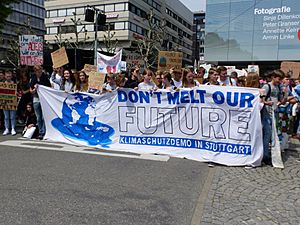
A second wave of global climate strikes started on May 24, 2019. Hundreds of thousands of students protested. They were in over 1600 towns in at least 125 countries. Greta Thunberg said the strike aimed to influence the 2019 European Parliament election. Polls showed climate change was a very important issue for voters.
International Climate Strike in Aachen on June 21, 2019
Fridays for Future Germany organized a large climate strike. It was called "Climate justice without borders – United for a future." People from 17 countries were invited. Many artists and activists also joined.
The city of Aachen had declared a "climate emergency" just before this event.
Global Week for Future in September 2019
The Global Week for Future was a series of strikes and events. It ran from September 20–27, 2019. The main days were September 20 and 27. These protests were planned around the 2019 UN Climate Action Summit on September 23. They took place in 4500 locations across 150 countries.
Organizers reported that over 4 million people joined the September 20 protests. This included 1.4 million in Germany and 300,000 in Australia. The September 27 protests gathered 1 million people in Italy.
Why Scientists Support the Strikes
Most scientists agree that the greenhouse effect is increasing. This is due to human activities releasing large amounts of carbon dioxide and other gases. In the past, the greenhouse effect kept Earth from being covered in ice. But since the Industrial Revolution, carbon dioxide has increased. This causes harmful global warming and climate change.
Adults in power, like fossil fuel companies and governments, are seen as responsible. They are not doing enough to reduce emissions. Over 12,000 scientists stated in 2019 that "Young people’s concerns are justified and supported by the best available science."
Scientists for Future
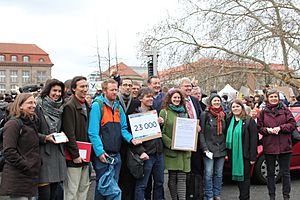
On January 31, 2019, over 3400 Belgian scientists signed a letter. It supported the school strikes. The letter said, "On the basis of the facts supplied by climate science, the campaigners are right. That is why we, as scientists, support them." Similar letters were signed by 340 scientists in the Netherlands and 1200 in Finland.
In Germany, Austria, and Switzerland, scientists formed "Scientists for Future" (S4F). They supported the facts presented by the movement. Over 26,000 German-speaking scientists signed their statement.
On March 14, 2019, the Club of Rome supported Greta and the strikes. They urged governments to cut global carbon emissions.
In April 2019, a letter called "Concerns of young protesters are justified" was published in Science. It said the climate strikers' concerns are "justified and supported by the best available science." Over 3000 scientists worldwide signed it.
In June 2019, 1000 healthcare professionals called for action. They supported the school strike movement.
How Adults Reacted to the Strikes
Adults in charge have both praised and criticized the strikes. In the European Union, the Volt Europa party strongly supported the movement. They shared all the demands of Fridays For Future.
Some politicians in the UK and Australia called the strikes "truancy" (skipping school without permission). Some students faced consequences. UK Prime Minister Theresa May said the strikes wasted lesson time. However, Jeremy Corbyn, leader of the Labour Party, supported the strikes. UK energy minister Claire Perry said she would have joined them when she was younger.
David Reed, from Generation Change, noted that school leaders missed the point. He said that engaged students taking action on climate change shows educational excellence.
Australia's Prime Minister Scott Morrison asked for "more learning and less activism." Education Minister Dan Tehan said students should protest after school or on weekends.
In New Zealand, reactions were mixed. Some principals threatened to mark students as truant. Politician Judith Collins dismissed the strike's impact. But Climate Change Minister James Shaw supported it. He noted that weekend protests get less attention.
On March 15, 2019, UN General Secretary António Guterres supported the strikers. He admitted his generation had failed to address climate change. He said, "No wonder they are angry." Guterres invited world leaders to a UN summit in September 2019. He asked for "concrete realistic plans" to improve climate action.
Many parents, including famous people, have supported the children's climate strikes.
Awards and Recognition
On June 7, 2019, Fridays for Future and Greta Thunberg received an award. It was Amnesty International's Ambassador of Conscience award. Secretary General Kumi Naidoo said: "We are humbled and inspired by the determination with which youth activists across the world are challenging us all to confront the realities of the climate crisis. Every young person taking part in Fridays for Future embodies what it means to act on your conscience. They remind us that we are more powerful than we know and that we all have a role to play in protecting human rights against climate catastrophe."
Images for kids
See also
 In Spanish: Fridays For Future para niños
In Spanish: Fridays For Future para niños


